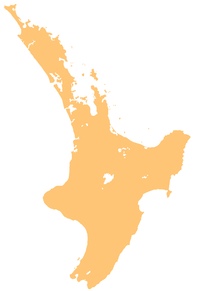- Hamilton International Airport
-
Hamilton International Airport IATA: HLZ – ICAO: NZHN Location of airport in North Island Summary Airport type Public Operator Hamilton International Airport Location Hamilton, New Zealand Elevation AMSL 172 ft / 52 m Coordinates 37°52′0″S 175°19′55″E / 37.866667°S 175.33194°E Website Runways Direction Length Surface ft m 18L/36R 7,202 2,195 Asphalt 18R/36L 2,592 790 Asphalt/Grass 07L/25R 2,362 720 Grass 07R/25L 2,345 715 Grass For the airport in Hamilton, Ontario, Canada, see Hamilton/John C. Munro International Airport.
The Hamilton International Airport (IATA: HLZ, ICAO: NZHN) is an airport located in the Waikato region, in New Zealand. It is sited at Rukuhia, which was the name of the Royal New Zealand Air Force base on that site during World War II.
Contents
History
As the world prepared for war, it became clear that a landing strip needed to be constructed in the Hamilton area. By 1935, the air strip was already in service, as a stop over for military aircraft that would land after a long journey. Services provided refueling as well as food and rest for the incoming pilots.
Tourism by air began to blossom soon after the war was over, and, in 1950, the airport received its first commercial flight. The main runway was sealed in 1965, and turboprop flights began to Hamilton that year, with NAC's Fokker Friendship aircraft. In 1988, one of the airport's runways was expanded, to accommodate the increasing number of international flights coming from Australia.
In 1989, the New Zealand government sold the airport to councils representing Hamilton city (50 percent), Waikato district (15.625 percent), Waipa district (15.625 percent), Matamata-Piako district (15.625 percent) and Otorohonga district (3.125 percent). This development led to unprecedented growth for the airport.
In 1994 the airport became a terminal for Trans Tasman air routes, with charter flights provided on Boeing 757s by Kiwi International Airlines of New Zealand (not to be confused with the United States based Kiwi International Air Lines). New Zealand's Kiwi went bankrupt in 1996, but by that time Freedom Air, had begun flying the same route with Boeing 737 aircraft. Freedom Air ultimately decided to make Hamilton International Airport their company hub.
Ansett built an independent passenger terminal to the south of the main building. Equipping it with a 'Golden Wing Club' lounge and food vending machines. The airline's Ansett NZ division, operated flights to Wellington from Hamilton from 1995 until 2000, when Ansett NZ was sold to a New Zealand business consortium and rebranded Qantas NZ, with their own New Zealand domestic flights division. Qantas NZ operated at the airport until 2001 when it went into receivership. The terminal was then occupied by Origin Pacific airlines. This airline operated domestic services until it too went bankrupt in 2004. The small terminal was then left unused.
In 1998 Hamilton Airport Motor Inn was developed to cater for travellers using the airport.
A NZ$15.3 million terminal expansion begun in 2005 featured a 60 percent increase in floorspace with improved baggage handling areas, better international and domestic check-in space, and passenger security screening. It was completed in late 2007.
Hamilton Airport is home to the New Zealand "Crew Training Centre" of CTC Aviation. CTC is a British flight training organisation that provides freshly trained European airline pilots to numerous airlines throughout the United Kingdom, most notably EasyJet, and also including British Airways, First Choice, Thomas Cook, and Monarch amongst others. Most of the non-passenger traffic at this airport is generated by CTC training flights, in single engined Diamond DA20 and Cessna 172, and twin-engined Diamond DA42 Twin Star aircraft.
Hugh McCarroll was the airport's chief executive from the early 2000s until retirement in February 2006. Current chief executive is Chris Doak, formerly growth and development general manager for electricity utilities company WEL Networks.
Capabilities
The airport currently accommodates many different types of aircraft, from piston-engined light aircraft to commercial turboprop aircraft such as the ATR 72. The airport can handle all light business jets as well as 40-80 seat regional jets such as the Embraer E195 and Bombardier CRJ200. Several airliners can operate from the airport including the 100-200 seat Boeing 737, Boeing 757 and Airbus A320. The largest aircraft authorised to land at Hamilton are the 150-250 seat Boeing 767 and Airbus A300 . Plans to increase runway length from 2195m to 3000m to attract larger aircraft and start Asian regional flights, have been considered.[1]
The airport operates 24 hours a day, seven days a week.
August 2011: Approval has been got by Hamilton International Airport to extent its runway up to 3,000 metres long as same size as secondary airports in other parts of the world, such as the Gold Coast. It will finish before 15 years approval end.[2]
Airlines and destinations
Airlines Destinations Type Air New Zealand operated by Air Nelson Christchurch, Wellington Domestic Air New Zealand operated by Eagle Airways Auckland, Palmerston North Domestic Air New Zealand operated by Mount Cook Airline Christchurch, Wellington, Palmerston North Domestic Sunair Gisborne, Kerikeri, Napier, Palmerston North, Whangarei Domestic Virgin Australia operated by Pacific Blue Brisbane International References
- ^ "Waikato plans flights to Asia". The Dominion Post. http://www.stuff.co.nz/4314804a34.html. Retrieved October 2, 2011.
- ^ "Hamilton Airport to extend its runway". August 12, 2011. http://www.nzherald.co.nz/nz/news/article.cfm?c_id=1&objectid=10744591&ref=rss.
External links
Categories:- Airports in New Zealand
- Buildings and structures in Hamilton, New Zealand
- Geography of Hamilton, New Zealand
Wikimedia Foundation. 2010.

